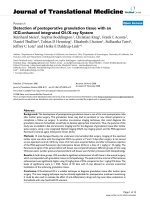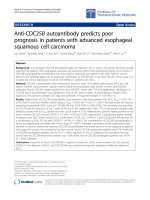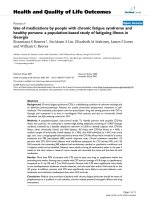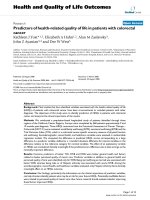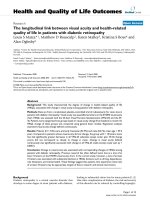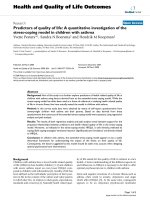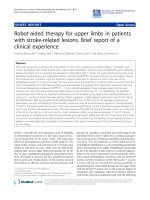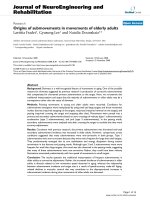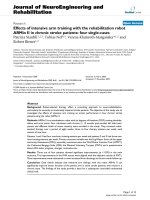báo cáo hóa học: " Predictors of health-related quality of life in patients with colorectal cancer" doc
Bạn đang xem bản rút gọn của tài liệu. Xem và tải ngay bản đầy đủ của tài liệu tại đây (292.21 KB, 10 trang )
BioMed Central
Page 1 of 10
(page number not for citation purposes)
Health and Quality of Life Outcomes
Open Access
Research
Predictors of health-related quality of life in patients with colorectal
cancer
Kathleen J Yost*
1,2
, Elizabeth A Hahn
1,2
, Alan M Zaslavsky
3
,
John Z Ayanian
3,4
and Dee W West
5
Address:
1
Center on Outcomes, Research and Education, Evanston Northwestern Healthcare, Evanston, IL 60201, USA,
2
Department of Preventive
Medicine, Feinberg School of Medicine, Northwestern University, Chicago, IL 60611, USA,
3
Department of Health Care Policy, Harvard Medical
School, Boston, MA 02115, USA,
4
Division of General Medicine, Brigham and Women's Hospital, Boston, MA 02115, USA and
5
Northern
California Cancer Center, Fremont, CA 94538, USA
Email: Kathleen J Yost* - ; Elizabeth A Hahn - ; Alan M Zaslavsky - ;
John Z Ayanian - ; Dee W West -
* Corresponding author
Abstract
Background: Most studies that have identified variables associated with the health-related quality of life
(HRQL) of patients with colorectal cancer have been cross-sectional or included patients with other
diagnoses. The objectives of this study were to identify predictors of HRQL in patients with colorectal
cancer and interpret the clinical importance of the results.
Methods: We conducted a population-based longitudinal study of patients identified through three
regions of the California Cancer Registry. Surveys were completed by 568 patients approximately 9 and
19 months post-diagnosis. Three HRQL outcomes from the Functional Assessment of Cancer Therapy –
Colorectal (FACT-C) were evaluated: social/family well-being (SWB), emotional well-being (EWB) and the
Trial Outcome Index (TOI), which is a colorectal cancer-specific summary measure of physical function
and well-being. Sociodemographic, cancer/health, and healthcare variables were assessed in multivariable
regression models. We computed the difference in predicted HRQL scores corresponding to a large
difference in a predictor variable, defined as a 1 standard deviation difference for interval variables or the
difference relative to the reference category for nominal variables. The effect of an explanatory variable
on HRQL was considered clinically meaningful if the predicted score difference was at least as large as the
minimally important difference.
Results: Common predictors of better TOI, SWB and EWB were better general health and factors
related to better perceived quality of cancer care. Predictor variables in addition to general health and
perceived quality of care were identified only for SWB. Being married/living as married was associated with
better SWB, whereas being male or of Hispanic ethnicity was associated with worse SWB. Among the
sociodemographic, cancer/health, and healthcare variables evaluated, only Hispanic ethnicity had a clinically
meaningful effect on an HRQL outcome.
Conclusion: Our findings, particularly the information on the clinical importance of predictor variables,
can help clinicians identify patients who may be at risk for poor future HRQL. Potentially modifiable factors
were related to perceived quality of cancer care; thus, future research should evaluate whether improving
these factors improves HRQL.
Published: 25 August 2008
Health and Quality of Life Outcomes 2008, 6:66 doi:10.1186/1477-7525-6-66
Received: 15 March 2008
Accepted: 25 August 2008
This article is available from: />© 2008 Yost et al; licensee BioMed Central Ltd.
This is an Open Access article distributed under the terms of the Creative Commons Attribution License ( />),
which permits unrestricted use, distribution, and reproduction in any medium, provided the original work is properly cited.
Health and Quality of Life Outcomes 2008, 6:66 />Page 2 of 10
(page number not for citation purposes)
Background
Most patients with colorectal cancer survive at least five
years after diagnosis [1], making health-related quality of
life (HRQL) an important outcome for these patients.
Patient-reported outcomes including HRQL have been
used in conjunction with traditional clinical outcomes,
such as treatment response rates and disease-free survival,
to assess treatment efficacy in randomized clinical trials
[2-4]. HRQL is also used in quality of care research [5] and
is a predictor of survival of patients with colorectal cancer
[6-8]. Understanding the characteristics or conditions that
predict subsequent HRQL may help clinicians identify
patients who are at risk for poor HRQL. Furthermore, if a
characteristic or condition is modifiable, an intervention
to alter it could lead to improved HRQL.
Most studies of HRQL of patients with colorectal cancer
have been cross-sectional [9-11]. While cross-sectional
analyses are valuable, longitudinal analyses of predictors
of HRQL are needed to understand how HRQL changes
over time [11]. Previous studies of HRQL that combined
data from patients with colorectal cancer and patients
with other diagnoses such as breast or lung cancer [12-14]
may have failed to identify relationships involving dis-
ease- and treatment-related side-effects specific to patients
with colorectal cancer. Furthermore, previous research
tends to focus on the HRQL of cancer patients while in
treatment [15] or the HRQL of cancer survivors several
years post-diagnosis [16-18]. Less is known about HRQL
during the period when patients have completed treat-
ment and are transitioning to the survivorship phase. A
final limitation of previous research on predictors of
HRQL is that it has not considered whether the variables
identified based on statistical criteria are also clinically
meaningful. Therefore, our study had the following two
objectives: (1) to identify variables that predict HRQL in a
prospective, population-based study of patients with
colorectal cancer, and (2) to interpret the regression
results in the context of clinical importance.
Methods
Study population
Men and women aged 40 to 84 diagnosed with invasive
(i.e., excluding in situ) colorectal cancer from April 1999
through June 2000 were identified from three of the ten
regional registries that comprise the statewide population-
based California Cancer Registry (CCR): Region 1 (San
Jose/Monterey area), Region 3 (Sacramento area), and
Region 8 (San Francisco/Oakland area) [19].
Timing of assessments
This study employed rapid case ascertainment to identify
eligible patients within 3 to 6 months of diagnosis.
Respondents were first assessed in an initial survey an
average of 9.2 months (range 4.6 – 23.0 months; SD 2.6
months) post-diagnosis when most patients would have
recovered from their cancer surgery and completed their
adjuvant treatment, if any. The primary purpose of the ini-
tial survey was to assess the quality of care for colorectal
cancer by hospital and patient characteristics. The initial
survey, as previously described [20], was completed by
1,079 English- or Spanish-speaking respondents
(response rate 72.4%).
Patients were eligible for participation in the follow-up
survey if they completed the initial survey and were Eng-
lish-speaking. A total of 830 English-speaking respond-
ents in the initial survey were invited to participate in the
follow-up survey an average of 19.1 months (range 13.0 –
31.8 months; SD 2.7 months) after diagnosis when most
patients would be in a relatively stable disease state. The
average time between the initial and follow-up surveys
was 10.2 months (range 4.7 – 17.4 months; SD 1.8
months). Data for both the initial and follow-up surveys
were collected predominantly via telephone by trained
interviewers from the California Public Health Institute's
Survey Research Group. Some patients were surveyed
through a mailed, self-administered questionnaire, partic-
ularly patients who were hearing-impaired or not success-
fully contacted by telephone. Institutional review boards
of the California Department of Health Services, Public
Health Institute, Harvard Medical School, and the North-
ern California Cancer Center approved the study proto-
cols for the initial and follow-up surveys. Participant
consent was obtained prior to conducting the surveys.
Surveys
HRQL was measured in the initial and follow-up surveys
with the Functional Assessment of Cancer Therapy-Color-
ectal (FACT-C) [21]. The FACT-C is a valid and reliable
measure of HRQL and includes five subscales: Physical
Well-Being (PWB, 7-items), Functional Well-Being (FWB,
7-items), Social/family Well-Being (SWB, 7-items), Emo-
tional Well-Being (EWB, 6-items), and the Colorectal
Cancer Subscale (CCS, 7-items), which measures con-
cerns specific to colorectal cancer patients such as appetite
and bowel control [21]. The FACT-C was scored as
described in the documentation for the instrument, with
higher scores indicating better HRQL [22]. The Trial Out-
come Index (TOI), derived as the sum of the PWB, FWB,
and CCS subscales, is a summary measure of physical
function and well-being in colorectal cancer patients that
is useful as a patient-reported outcome in pharmacologic
interventions [21]. The TOI and the remaining two sub-
scales, SWB and EWB, were the HRQL outcomes evaluated
in this study.
Patients' perceived quality of cancer care was measured
using 31 items obtained from the Picker Institute of Bos-
ton, Massachusetts [20,23,24] that measure problems
Health and Quality of Life Outcomes 2008, 6:66 />Page 3 of 10
(page number not for citation purposes)
associated with six aspects of cancer care: psychosocial
care, access to cancer care, treatment information, health
information, confidence in providers, and coordination
of care. Two items measuring patients' perceptions of how
well healthcare providers controlled their pain/discom-
fort and nausea/vomiting were also included. Higher
scores indicate greater perceived problems with care.
Limitations due to each of 14 comorbid conditions were
measured in the initial survey and scored as 0 if the con-
dition was not present, 1 if the condition was present but
did not limit the patient, or 2 if the condition was present
and limited the patient. Scores were summed to create a
comorbidity index (range 0 to 28) [12,25]. General health
was measured with a single item from the Medical Out-
comes Study 36-item Short form (SF-36) health survey
[26]. Bowel function and overall bowel problems were
measured with items from the Prostate Cancer Outcomes
Study [27]. Respondents who had a colostomy at the time
of the interviews were not asked these bowel-related
items, including 131 (12.1%) of 1,079 patients in the ini-
tial survey and 54 (9.5%) of 568 patients in the follow-up
survey.
Sociodemographic information collected via survey
included race/ethnicity, education, household income,
financial difficulty due to cancer, occupational status,
marital status, and number of persons living in the house-
hold. Gender, age at diagnosis and stage at diagnosis were
obtained from the CCR. Neighborhood socioeconomic
status (SES) was calculated based on 2000 U.S. Census
data using methods described in Yost et al. [28].
Data analyses
Non-response bias
To assess potential non-response bias, characteristics of
eligible patients who did not participate in the follow-up
survey were compared to those of patients who did using
standard statistical tests for continuous and categorical
data. All candidate predictor variables for the longitudinal
analyses were measured either at the time of diagnosis or
during the initial survey.
Regression models
Because previous studies of predictors of HRQL are incon-
clusive [11-13,17,29-31], we adopted an exploratory
approach to identify variables predictive of HRQL at the
follow-up survey. The range of time since diagnosis for the
initial survey (4.6 – 23.0 months) overlapped with that
for the follow-up survey (13.0 – 31.8 months). Therefore,
we created non-overlapping time periods for each survey
centered around the means (i.e., 9 months for initial sur-
vey and 19 months for the follow-up survey). The time
period for the initial survey was restricted from 4 to less
than 14 months post-diagnosis and the time period for
the follow-up survey was restricted from 14 to less than 24
months post-diagnosis. The regression analyses were
restricted to participants who completed their initial and
follow-up surveys within these ranges. This resulted in the
exclusion of 43 participants who were missing data for
time since diagnosis for either the initial or follow-up sur-
vey and 29 participants who were outside of the restricted
time frames. Following these exclusions, the mean times
since diagnosis for the 496 respondents were 8.6 months
(range 4.6–13.9, SD 1.7) for the initial survey and 18.8
months (range 14.0–24.0, SD 2.1) for the follow-up sur-
vey.
Separate linear regression analyses [32] were conducted
for each of the three HRQL outcomes measured at the fol-
low-up survey using the following candidate predictor
variables. Initial HRQL: TOI, SWB or EWB measured at
the initial survey. Sociodemographic: age at diagnosis,
gender, race/ethnicity, marital status (married/living as
married vs. not married), education (high school or less
vs. technical school or some college, college or higher),
occupational status (working vs. not working), number in
household, neighborhood SES (standardized principal
component score [28]), financial problems due to cancer,
and household income (missing, <$25,000, $25,000–
$50,000 vs. $50,000+). Household income was not
reported by 58 (10.2%) respondents. Rather than exclude
these respondents from the analyses, "missing" income
was treated as a separate income category. Cancer/health:
stage at diagnosis (Stage I/II/III vs. Stage IV), general
health, colostomy (yes/no), history of radiation therapy
(yes/no), history of chemotherapy (yes/no), currently
receiving chemotherapy at the time of the initial survey
(yes/no), comorbidity index, bowel function, overall
bowel problems, family history of colorectal cancer (yes/
no), time since diagnosis, and site (colon vs. rectum).
Healthcare: type of health insurance [Medicare, other/
none (e.g., Medicaid, other government-provided, unin-
sured) vs. commercial (e.g., HMO, PPO, private)], six
domains of perceived quality of care, control of pain and
discomfort (definitely vs. somewhat/not at all) and con-
trol of nausea and vomiting (definitely vs. somewhat/not
at all).
Variables associated with HRQL were selected in two
stages. First, follow-up HRQL was regressed on initial
HRQL plus one other candidate variable. Candidate vari-
ables that had a significant relationship with follow-up
HRQL by a liberal (p < 0.25) criterion were identified [33].
These variables were then combined into a multivariable
model. Backward elimination with a criterion of p < 0.05
for retention was used to select a final model. We also con-
ducted forward and stepwise regression to determine
whether the same model was identified. Multicollinearity
in the final models was assessed with the variance infla-
Health and Quality of Life Outcomes 2008, 6:66 />Page 4 of 10
(page number not for citation purposes)
tion factor (VIF). To facilitate interpretation of our regres-
sion results, we report squared semi-partial correlations
(sr
2
) in addition to p-values. Because the sr
2
expresses the
unique variance in the dependent variable explained by a
predictor variable, it is a useful measure of the importance
of a predictor [34].
Meaningful effects
We assessed the clinical meaningfulness of each predictor
variable [35,36]. For interval variables (e.g., age), we com-
puted the difference in predicted HRQL scores corre-
sponding to a large difference in a predictor variable,
defined as a 1 SD difference [37], where the SD was based
on the data for the 496 respondents evaluated in the
regression analyses. For nominal variables (e.g., race/eth-
nicity), we computed the difference in the predicted
HRQL score relative to the reference category. The effect of
an explanatory variable on follow-up HRQL was consid-
ered meaningful if the corresponding predicted score dif-
ference was at least as large as the minimally important
difference (MID), which we defined as the smallest differ-
ence in HRQL scores that patients perceive as important,
and thus might lead a clinician to consider changing the
patient's management [38]. MIDs have been determined
for the TOI (4–6 points) [39] and the SWB and EWB sub-
scales (2–3 points) [40]. We used the lower bounds of
these ranges to identify clinically meaningful effects as an
indication of the potential prognostic impact of predictor
variables. We also computed the percent of patients
whose HRQL improved or declined more than the lower
bound of the MID range.
Results
Sample characteristics
Of the 830 English-speaking patients invited to participate
in the follow-up study, 26 were ineligible because they
had died. Follow-up surveys were completed by 568
(70.6%) of the 804 eligible patients. Of the 236 patients
who did not participate in the follow-up study, 28 were
either hearing or mentally impaired or too ill to partici-
pate, 79 refused, and 129 were not successfully contacted.
Table 1 summarizes the characteristic at the time of diag-
nosis or at the time of the initial survey for the 496 partic-
ipants of the follow-up survey with non-overlapping
survey periods who were evaluated in this study. Charac-
teristics for all 568 respondents and the 236 non-respond-
ents of the follow-up survey are also described in Table 1.
Non-respondents were significantly more likely to be
non-white, unmarried, with low income, more financial
problems due to cancer, longer time since diagnosis, have
more perceived problems with access to care, confidence
in providers, and coordination of care, and more per-
ceived problems with control of pain/discomfort. They
were significantly less likely to be on chemotherapy at the
time of the initial survey. HRQL scores measured in the
initial survey were lower for non-respondents than for
respondents of the follow-up survey. Cronbach's alpha, a
measure of reliability, was acceptable (≥0.70) in both the
initial and follow-up surveys, respectively, for the TOI
scale (0.90, 0.90) and the SWB (0.74, 0.77) and EWB
(0.74, 0.76) subscales. The 95% confidence intervals
around the initial scores for SWB (22.9, 23.7) and EWB
(20.1, 20.7) for the 568 respondents did not contain the
general U.S. population norms of 19.1 and 19.9 for the
SWB and EWB, respectively [41], nor did they contain the
norms for colon cancer patients of 22.0 and 19.8, respec-
tively [22]. This indicates that the respondents had signif-
icantly higher scores for these domains than the norms.
There are no general or cancer-specific norms for the TOI.
Clinically meaningful change in HRQL
The percent of patients with a clinically meaningful
decline in EWB scores from the initial to follow-up survey
was exactly the same as the percent with a clinically mean-
ingful improvement (Table 2). Slightly more patients had
a meaningful improvement than decline in TOI scores,
but fewer patients had a meaningful improvement than
decline in SWB scores. EWB scores were the most stable,
with 47.6% of patients experiencing a change less than the
MID. The magnitude of the average decline in scores was
slightly larger than that of the average improvement for all
three HRQL outcomes.
Prognostic impact on patient-reported HRQL
Predictors of follow-up TOI scores
In addition to initial TOI scores, two variables were
retained as predictors of follow-up TOI following back-
ward elimination (Table 3), accounting for 43.9% of the
variance. Forward and stepwise selection identified the
same model. No sociodemographic variables were
retained. One cancer/health-related variable, general
health, was retained. The Treatment Information problem
score from the Picker Institute measure was the only
healthcare variable retained. Only initial TOI was a clini-
cally meaningful predictor of follow-up TOI, with a 1 SD
increase (12.7 points) in initial TOI scores corresponding
to a 6.4 point increase in follow-up TOI scores. Initial TOI
accounted for the largest proportion of variance, as indi-
cated by the sr
2
. The p-value, sr
2
and effect on follow-up
TOI indicated that general health had a greater prognostic
impact than Treatment Information. All VIFs were less
than 2.0 indicating there was no multicolinearity among
the predictors.
Predictors of follow-up SWB scores
Backward selection identified a model with six statistically
significant predictors of follow-up SWB explaining a total
of 39.3% of the variance (Table 4), including initial SWB,
three sociodemographic indicators (gender, race/ethnic-
Health and Quality of Life Outcomes 2008, 6:66 />Page 5 of 10
(page number not for citation purposes)
Table 1: Characteristics of follow-up survey respondents and non-respondents at the time of diagnosis or the initial survey
Variable Type Variable
a
Evaluated
Respondents
(n = 496)
b,c
Assessment of Response Bias
b
Follow-up
Survey
Respondents
(n = 568)
Follow-up
Survey
Non-Respondents
(n = 236)
p-value
d
Sociodemographic Age at diagnosis (years) [mean (SD)] 66.8 (10.4) 66.7 (10.5) 65.0 (12.1) 0.07
Male 48.0 48.6 50.0 0.72
Race/ethnicity
Non-Hispanic White 80.0 79.8 67.8 <0.001
Non-Hispanic Black 5.7 5.6 14.0
Hispanic 7.5 7.0 9.3
Asian/Other 6.9 7.6 8.9
Married/Living as married 65.9 65.7 56.6 0.02
Education
High school or less 38.1 38.2 44.0 0.30
Post high school training/some college 30.7 31.1 27.8
College degree or higher 31.1 30.7 28.2
Working 28.6 28.8 29.7 0.80
Household Income
Missing 8.9 10.2 11.9 <0.001
Less than $25,000 22.4 23.1 36.0
$25,000 to $50,000 31.1 30.3 20.8
Over $50,000 37.7 36.4 31.4
Financial problems due to cancer
Not at all 76.6 77.2 66.4 0.01
A little 10.9 10.2 16.4
Somewhat 7.3 7.1 11.2
A lot 5.0 5.5 6.0
Cancer/Health-related Late Stage (Stage IV) 8.3 7.8 10.2 0.26
General Health
Poor 5.0 5.3 5.1 0.21
Fair 23.2 22.4 23.3
Good 38.7 38.2 41.1
Very Good 21.2 22.7 24.6
Excellent 11.9 11.4 5.9
Colostomy 14.5 14.5 15.7 0.67
History of radiation therapy 15.3 17.4 19.4 0.51
History of chemotherapy 51.6 49.2 42.0 0.07
Receiving chemotherapy at time of initial survey 30.9 30.1 19.5 0.002
Comorbidity Index [median (IQR)] 2 (1–4) 2 (1–4) 3 (1–4) 0.08
Bowel Function [mean (SD)] 8.6 (2.3) 8.6 (2.3) 8.8 (2.4) 0.42
Time since diagnosis [mean (SD)] 8.6 (1.7) 9.2 (2.6) 9.8 (3.1) 0.02
Healthcare Type of Insurance
Medicare 24.2 24.3 28.8 0.40
Commercial Insurance 68.2 68.0 64.4
Other/none 7.7 7.8 6.8
Picker problem scores [mean, (SD)]
Psychosocial Care 30.6 (28.9) 30.7 (28.5) 32.4 (28.1) 0.45
Access to Care 10.8 (22.5) 10.7 (22.4) 16.7 (26.9) 0.003
Treatment Information 30.4 (30.7) 30.5 (30.9) 33.9 (33.6) 0.17
Health Information 46.1 (33.6) 46.6 (33.6) 49.6 (35.7) 0.25
Confidence in Providers 11.7 (20.6) 11.8 (21.4) 15.5 (26.7) 0.05
Coordination of Care 19.4 (23.5) 19.0 (23.5) 24.4 (27.4) 0.008
Control of Nausea/Vomiting (% somewhat/not at all) 11.3 10.9 14.0 0.22
Control of Pain (% somewhat/not at all) 10.3 10.4 18.2 0.002
Health and Quality of Life Outcomes 2008, 6:66 />Page 6 of 10
(page number not for citation purposes)
ity, marital status), one cancer/health-related indicator
(general health), and one healthcare measure (problems
with control of pain/discomfort). Forward and stepwise
selection yielded a slightly different model that did not
include gender and marital status. We report the model
identified using backward selection as it had a larger
adjusted R
2
(39.3 vs. 38.1). Both initial SWB and Hispanic
ethnicity were clinically meaningful predictors of follow-
up SWB. Hispanic ethnicity also had a larger sr
2
relative to
the other sociodemographic, cancer/health and health-
care variables.
Predictors of follow-up EWB scores
Predictors of EWB at the follow-up survey included initial
EWB, general health and control of nausea/vomiting,
explaining 36.5% of the variance (Table 5). Backward, for-
ward and stepwise selection all identified the same model.
After initial EWB, general health had the largest sr
2
, while
problems with control of nausea/vomiting had the largest
prognostic impact as indicated by the size of the effect on
follow-up EWB. Initial EWB was the only meaningful pre-
dictor of follow-up EWB.
Discussion
Exploratory longitudinal analyses were conducted to eval-
uate the relationship between three HRQL outcomes and
sociodemographic, cancer/health, and healthcare varia-
bles in a population-based sample of patients with color-
ectal cancer. General health was the only variable
common to all three outcomes, although each model also
contained a quality of care variable: Perceived problems
with Treatment Information was a predictor of follow-up
TOI, perceived problems with control of pain/discomfort
predicted follow-up SWB and perceived problems with
control of nausea/vomiting was a predictor of follow-up
EWB.
Rather than relying solely on statistical measures such as
p-values and sr
2
to interpret the results of the regression
analyses, we also used clinical meaningfulness of the
effect of a predictor variable on the HRQL outcome. For
follow-up TOI, both initial TOI and general health were
highly statistically significant predictors (p < 0.001). The
sr
2
for general health was smaller than that for initial TOI,
but even with this information, it may still not be intuitive
to some clinicians or researchers whether to consider gen-
eral health as an important predictor. By considering the
clinical importance of these variables, we showed that
even a large (1 SD) difference in the general health score
would not have a clinically meaningful effect on follow-
up TOI scores. This information may help clinicians and
researchers understand the results regardless of their
familiarity with regression modeling or the FACT-C
instrument.
Perceived problems with Treatment Information was also
retained in the model for follow-up TOI. A measure of
perceived quality of treatment information is not com-
monly included in studies aimed at identifying predictors
of HRQL. That this variable was identified in our study as
a significant predictor of HRQL over other commonly
evaluated variables such as gender, age, and comorbidities
HRQL Initial HRQL scores [mean, (SD)]
TOI 66.6 (12.7) 66.9 (12.7) 64.6 (13.7) 0.02
SWB 23.2 (4.4) 23.2 (4.6) 22.0 (5.1) 0.002
EWB 20.4 (3.7) 20.4 (3.7) 19.6 (4.5) 0.02
HRQL, Health-related Quality of Life; TOI, Trial Outcome Index-Colorectal; SWB, Social/family well-being; EWB, Emotional well-being; SD,
standard deviation; IQR, interquartile range.
a
Data for all variables were collected via self report in the initial survey except gender, stage at diagnosis and age, which were reported to the
California Cancer Registry at the time of diagnosis.
b
Numbers represent percentages unless otherwise specified.
c
Participants with non-overlapping survey periods who were evaluated in the regression analyses.
d
p-value for response bias at follow-up. Compares follow-up respondents (n = 568) and non-respondents (n = 236).
Table 1: Characteristics of follow-up survey respondents and non-respondents at the time of diagnosis or the initial survey (Continued)
Table 2: Clinically meaningful change in HRQL* from the initial to follow-up surveys
Change in HRQL TOI SWB EWB
n (%) mean (SD) n (%) mean (SD) n (%) mean (SD)
Meaningful Decline 161 (32.5) -11.0 (6.2) 167 (33.7) -5.2 (3.2) 130 (26.2) -4.5 (2.7)
About the same 163 (32.9) .07 (2.0) 193 (38.9) 15 (.85) 236 (47.6) .05 (.70)
Meaningful Improvement 172 (34.7) 10.5 (7.3) 125 (25.2) 4.2 (2.4) 130 (26.2) 3.8 (2.2)
HRQL, Health-related Quality of Life; TOI, Trial Outcome Index-Colorectal; SWB, Social/family Well-being; EWB, Emotional Well-being
*Clinically meaningful change is at least 4 points for the TOI and at least 2 points for SWB and EWB.
Health and Quality of Life Outcomes 2008, 6:66 />Page 7 of 10
(page number not for citation purposes)
[12,17,30] warrants the addition of perceived quality of
treatment information to the list of candidate variables in
future research of HRQL predictors.
Relative to non-Hispanic White participants, Hispanic
participants had significantly lower follow-up SWB. Wan
et al. [14] also observed significantly lower SWB scores
among Hispanic cancer patients relative to White patients.
Both initial SWB and Hispanic ethnicity were highly sig-
nificantly related to follow-up SWB (p < 0.001). The sr
2
for
Hispanic ethnicity was much smaller than that for initial
SWB suggesting that Hispanic ethnicity was the less influ-
ential predictor of the two. However, by considering clin-
ical importance, we obtained a slightly different
interpretation; that the two variables had comparable
clinically meaningful effects on follow-up SWB.
The relationship between gender and the social domain of
HRQL may depend on how the domain is measured. For
example, as measured in the present study with the FACT-
C, men had worse initial SWB (data not shown) and fol-
low-up SWB than women. Normative data for the SWB in
both the general U.S. population and cancer patients also
show lower average scores for men than women [41].
However, several studies have evaluated the relationship
between gender and social functioning as measured by the
EORTC QLQ-C30 in cancer patients and reported no dif-
ferences [31,42,43].
Although the association between being married/living as
married and having better physical and psychological
well-being is well established, the link between marital
status and SWB is less clear [44]. We found that married/
living as married persons had better SWB as measured by
the FACT-C, which is predominantly a measure of social
support and contains items such as "I get emotional sup-
port from my family" and "I feel close to my partner (or
the person who is my main support)." It is reasonable to
expect married/living as married persons to answer these
questions more favorably.
Table 3: Predictors of follow-up TOI
Variable Type Variable B (SE) p-value sr
2
Effect on
follow-up
HRQL*
HRQL Initial TOI .50 (.04) <.0001 .179 6.39
Cancer/Health-related General health 1.88 (.48) <.0001 .018 1.98
Healthcare Treatment information problem score 04 (.01) .005 .009 -1.18
Adjusted R
2
: 43.9
HRQL, Health-related Quality of Life; TOI, Trial Outcome Index-Colorectal; B, regression coefficient; SE, standard error; sr
2
, squared semi-partial
correlation
*Difference in predicted follow-up TOI score for a 1 SD difference in interval variables or the difference relative to the reference category for
nominal variables. Effects with a magnitude of at least 4 points are considered meaningful and are indicated in bold font.
Table 4: Predictors of follow-up SWB
Variable Type Variable B (SE) p-value sr
2
Effect on
follow-up
HRQL*
HRQL Initial SWB .59 (.04) <.0001 .222 2.59
Sociodemographic Male -1.08 (.39) .006 .010 -1.08
Race/ethnicity (ref = White)
Black 90 (.78) .25 .002 90
Hispanic -2.49 (.69) .0003 .016 -2.49
Asian/other -1.15 (.73) .11 .003 -1.15
Married/living as married 1.10 (.41) .008 .009 1.10
Cancer/Health-related General health .48 (.18) .009 .009 .51
Healthcare Problems with control of pain/discomfort -1.43 (.61) .02 .007 -1.43
Adjusted R
2
: 39.3
HRQL, Health-related Quality of Life; SWB, Social/family Well-being; B, regression coefficient; SE, standard error; sr
2
, squared semi-partial
correlation
*Difference in predicted follow-up SWB score for a 1 SD difference in interval variables or the difference relative to the reference category for
nominal variables. Effects with a magnitude of at least 2 points are considered meaningful and are indicated in bold font.
Health and Quality of Life Outcomes 2008, 6:66 />Page 8 of 10
(page number not for citation purposes)
Initial EWB was the only meaningful predictor of follow-
up EWB. After initial EWB, general health was the strong-
est predictor based on the p-value and sr
2
, but problems
with control of nausea and vomiting was the strongest
predictor based on the effect on follow-up EWB score.
Thus, by considering clinical importance, we obtained a
slightly different interpretation of the importance of these
two predictors.
The measures of perceived quality of care (problems with
Treatment Information, control of pain/discomfort, con-
trol of nausea/vomiting) are the only predictors of HRQL
in our study that are potentially modifiable. These varia-
bles are not typically included as predictors of HRQL in
multivariable regression analyses, yet they were more clin-
ically meaningful predictors of the HRQL outcomes than
some more commonly evaluated predictors, including
gender, marital status and general health. Additional
research is needed to better understand the association
between factors related to perceived quality of care at the
time of cancer treatment and HRQL at some follow-up
assessment. Furthermore, as these are potentially modifi-
able variables, intervention studies could explore meth-
ods for improving certain aspects of quality of care to
determine whether those changes lead to improved
HRQL.
While only a few of the statistically significant predictors
individually met our criteria for clinical importance, in
combination they may identify patients at high risk for
poor HRQL. For example, unmarried male patients with
worse general health and more perceived problems with
control of pain/discomfort may have meaningfully lower
average follow-up SWB scores (i.e., at least 2 points lower)
than married female patients with better general health
and fewer perceived problems with control of pain/dis-
comfort even after adjusting for initial SWB. Initial HRQL
was consistently the strongest predictor of follow-up
HRQL; therefore, clinicians could identify patients at risk
for poor future HRQL by routinely assessing HRQL in
clinical practice [45].
A strength of our study is that the respondents were iden-
tified through a population-based cancer registry and
were therefore representative of English-speaking colorec-
tal cancer patients in California. A potential limitation of
our study is possible non-response bias in the follow-up
sample. The follow-up respondents and non-respondents
differed significantly on a number of variables that may be
related to follow-up HRQL, which limits the generaliza-
bility of our results. In particular, non-respondents had
significantly lower initial HRQL than respondents and
therefore likely had lower follow-up HRQL. Nonresponse
might also have affected the selection and estimated prog-
nostic impact of predictors of HRQL. Another potential
limitation is that there may be other variables predictive
of follow-up HRQL that were not considered in this anal-
ysis. Variables such as spiritual well-being [14,46], opti-
mism [47], and sexual dysfunction [10] have been shown
to be related to HRQL. However, these topics were not
measured in the initial survey. The follow-up survey did
not measure whether the respondents had experienced a
recurrence or whether they were undergoing any adjuvant
treatment for either their primary or a recurrent cancer,
which could have affected their follow-up HRQL
[29,48,49]. Because of inconclusive results in the litera-
ture regarding variables that predict HRQL in colorectal
patients, we adopted an exploratory approach and evalu-
ated a large number of variables, including variables
rarely, if ever, evaluated previously in this population as
potential predictors, such as perceived quality of cancer
care. Thus, another potential limitation of our study is an
inflated type I error. The predictors of HRQL in patients
with colorectal cancer may differ from those in patients
with other types of cancer. Furthermore, the predictors of
HRQL may vary based on how HRQL is measured.
Conclusion
We identified sociodemographic, clinical, and healthcare
variables that predict HRQL as measured by the FACT-C.
The most consistent finding was that patients with poor
general health and problems with certain domains of per-
ceived quality of cancer care may be at risk for poor
Table 5: Predictors of follow-up EWB
Variable Type Variable B (SE) p-value sr
2
Effect on
follow-up
HRQL*
HRQL Initial EWB .55 (.04) <.0001 .210 2.05
Cancer/Health-related General health .54 (.15) .0004 .017 .56
Healthcare Problems with control of nausea/vomiting -1.25 (.46) .007 .009 -1.25
Adjusted R
2
: 36.5
HRQL, Health-related Quality of Life; EWB, Emotional Well-being; B, regression coefficient; SE, standard error; sr
2
, squared semi-partial
correlation
*Difference in predicted follow-up EWB score for a 1 SD difference in interval variables or the difference relative to the reference category for
nominal variables. Effects with a magnitude of at least 2 points are considered meaningful and are indicated in bold font.
Health and Quality of Life Outcomes 2008, 6:66 />Page 9 of 10
(page number not for citation purposes)
HRQL. Other characteristics that might identify at-risk
patients were specific to each HRQL outcome and
included being male, unmarried or Hispanic. Computing
the clinical importance of the effect on the HRQL out-
come helped to interpret the impact of specific statistically
significant predictors. As the only potentially modifiable
variables identified in our study were related to perceived
quality of cancer care, future research should evaluate
whether interventions aimed at improving these variables
enhances subsequent HRQL.
List of abbreviations
HRQL: Health-related quality of life; FACT-C: Functional
Assessment of Cancer Therapy-Colorectal; PWB: Physical
well-being; EWB: Emotional well-being; SWB: Social/fam-
ily well-being, FWB: Functional well-being; TOI: Trial out-
come index; CCR: California Cancer Registry; SD:
Standard deviation; HMO: Health maintenance organiza-
tion; PPO: Preferred provider organization; VIF: Variance
inflation factor.
Competing interests
The authors declare that they have no competing interests.
Authors' contributions
KJY, AMZ, JZA, and DWW made substantial contributions
to the study concept and design, EAH and AMZ provided
guidance on the statistical analysis, KJY conducted the sta-
tistical analysis, interpreted the results and drafted the
manuscript, EAH, AMZ, JZA, and DWW participated in
critical revisions of the manuscript for important intellec-
tual content. All authors read and approved the final man-
uscript.
Acknowledgements
This work was supported by grants from the Surveillance, Epidemiology and
End Results Special Study program (NO1-PC-65107), and the Agency for
Healthcare Research and Quality and the National Cancer Institute (R01
HS09869, U01 CA93324). The authors would like to thank William Wright
for his guidance on study design and the following individuals for assistance
with data collection and database management: Mark Allen, Gretchen Agha,
Craig Grilley, Scott Riddle, Bonnie Davis, Ann Hitchcock and staff of the
California Public Health Institute Survey Research Group. We also thank
David Eton for his thoughtful review and comments.
References
1. American Cancer Society: Cancer Facts and Figures, 2007.
Atlanta, GA, American Cancer Society; 2007.
2. Storniolo AM, Enas NH, Brown CA, Voi M, Rothenberg ML, Schilsky
R: An investigational new drug treatment program for
patients with gemcitabine: results for over 3000 patients
with pancreatic carcinoma. Cancer 1999, 85:1261-1268.
3. Passik SD, Kirsh KL: The importance of quality-of-life end-
points in clinical trials to the practicing oncologist. Hematol
Oncol Clin North Am 2000, 14:877-886.
4. Hahn EA, Glendenning GA, Sorensen MV, Hudgens SA, Druker BJ,
Guilhot F, Larson RA, O'Brien SG, Dobrez DG, Hensley ML, Cella D:
Quality of life in patients with newly diagnosed chronic phase
chronic myeloid leukemia on imatinib versus interferon alfa
plus low-dose cytarabine: results from the IRIS Study. J Clin
Oncol 2003, 21:2138-2146.
5. Treurniet HF, Essink-Bot ML, Mackenbach JP, van der Maas PJ:
Health-related quality of life: an indicator of quality of care?
Qual Life Res 1997, 6:363-369.
6. Maisey NR, Norman A, Watson M, Allen MJ, Hill ME, Cunningham D:
Baseline quality of life predicts survival in patients with
advanced colorectal cancer. Eur J Cancer 2002, 38:1351-1357.
7. Camilleri-Brennan J, Steele RJ: Prospective analysis of quality of
life and survival following mesorectal excision for rectal can-
cer. Br J Surg 2001, 88:1617-1622.
8. Efficace F, Innominato PF, Bjarnason G, Coens C, Humblet Y, Tumolo
S, Genet D, Tampellini M, Bottomley A, Garufi C, Focan C, Giacchetti
S, Levi F: Validation of patient's self-reported social function-
ing as an independent prognostic factor for survival in meta-
static colorectal cancer patients: results of an international
study by the Chronotherapy Group of the European Organ-
isation for Research and Treatment of Cancer. J Clin Oncol
2008, 26:2020-2026.
9. Sprangers MA, Taal BG, Aaronson NK, te Velde A: Quality of life in
colorectal cancer. Stoma vs. nonstoma patients. Dis Colon Rec-
tum 1995, 38:361-369.
10. Camilleri-Brennan J, Steele RJ: Quality of life after treatment for
rectal cancer. Br J Surg 1998, 85:1036-1043.
11. Dunn J, Lynch B, Aitken J, Leggett B, Pakenham K, Newman B: Qual-
ity of life and colorectal cancer: a review. Aust N Z J Public
Health 2003, 27:41-53.
12. Schag CA, Ganz PA, Wing DS, Sim MS, Lee JJ: Quality of life in
adult survivors of lung, colon and prostate cancer. Qual Life
Res 1994, 3:127-141.
13. Rustoen T, Moum T, Wiklund I, Hanestad BR: Quality of life in
newly diagnosed cancer patients. J Adv Nurs 1999, 29:490-498.
14. Wan GJ, Counte MA, Cella DF, Hernande L, Deasy S, Shiomoto G:
An analysis of the impact of demographic, clinical and social
factors on health-related quality of life. Value in Health 1999,
2:308-318.
15. Holloway S, Sarosi G, Kim L, Nwariaku F, O'Keefe G, Hynan L, Jones
C, Anthony T: Health-related quality of life and postoperative
length of stay for patients with colorectal cancer. J Surg Res
2002, 108:273-278.
16. Trentham-Dietz A, Remington PL, Moinpour CM, Hampton JM, Sapp
AL, Newcomb PA: Health-related quality of life in female long-
term colorectal cancer survivors. Oncologist 2003, 8:342-349.
17. Ramsey SD, Berry K, Moinpour C, Giedzinska A, Andersen MR:
Quality of life in long term survivors of colorectal cancer. Am
J Gastroenterol 2002, 97:1228-1234.
18. Anthony T, Jones C, Antoine J, Sivess-Franks S, Turnage R: The
effect of treatment for colorectal cancer on long-term
health-related quality of life. Ann Surg Oncol 2001, 8:44-49.
19. Kwong S, Perkins CI, Morris CR, Cohen R, Allen M, Wright WE:
Cancer in California: 1988-1999. Sacramento, CA, California
Department of Health Services, Cancer Surveillance Section; 2001.
20. Ayanian JZ, Zaslavsky AM, Guadagnoli E, Fuchs CS, Yost KJ, Creech
CM, Cress RD, O'Conner LC, West DW, Wright WE: Patients'
perceptions of quality of care for colorectal cancer by race,
ethnicity, and language. J Clin Oncol 2005, 23:6576-6586.
21. Ward WL, Hahn WA, Mo F, Hernandez L, Tulsky DS, Cella D: Reli-
ability and validity of the Functional Assessment of Cancer
Therapy-Colorectal (FACT-C) quality of life instrument.
Qual Life Res 1999, 8:181-195.
22. Cella D: Manual of the Functional Assessment of Chronic Ill-
ness Therapy (FACIT Scales) - Version 4.1. Evanston, IL,
Center on Outcomes, Research & Education (CORE), Evanston
Northwestern Healthcare and Northwestern University; 2004.
23. Cleary PD, Edgman-Levitan S: Health care quality. Incorporating
consumer perspectives. JAMA 1997, 278:1608-1612.
24. Cleary PD, McNeil BJ: Patient satisfaction as an indicator of
quality care. Inquiry 1988, 25:25-36.
25. Kaplan MH, Feinstein AR: The importance of classifying initial
co-morbidity in evaluating the outcome of diabetes mellitus.
J Chronic Dis 1974, 27:387-404.
26. Ware JE, Snow KK, Kosinski M: SF-36 Health Survey: Manual
and Interpretation Guide. Lincoln, RI, QualityMetric Incorpo-
rated; 2000.
Publish with BioMed Central and every
scientist can read your work free of charge
"BioMed Central will be the most significant development for
disseminating the results of biomedical research in our lifetime."
Sir Paul Nurse, Cancer Research UK
Your research papers will be:
available free of charge to the entire biomedical community
peer reviewed and published immediately upon acceptance
cited in PubMed and archived on PubMed Central
yours — you keep the copyright
Submit your manuscript here:
/>BioMedcentral
Health and Quality of Life Outcomes 2008, 6:66 />Page 10 of 10
(page number not for citation purposes)
27. Potosky AL, Harlan LC, Stanford JL, Gilliland FD, Hamilton AS,
Albertsen PC, Eley JW, Liff JM, Deapen D, Stephenson RA, Legler J,
Ferrans CE, Talcott JA, Litwin MS: Prostate cancer practice pat-
terns and quality of life: the Prostate Cancer Outcomes
Study. J Natl Cancer Inst 1999, 91:1719-1724.
28. Yost K, Perkins C, Cohen R, Morris C, Wright WE: Socioeconomic
status and breast cancer incidence in California for different
race/ethnic groups. Cancer Causes Control 2001, 12:703-711.
29. Parker PA, Baile WF, De Moor C, Cohen L: Psychosocial and
demographic predictors of quality of life in a large sample of
cancer patients. Psychooncology 2003, 12:183-193.
30. Ramsey SD, Andersen MR, Etzioni R, Moinpour C, Peacock S, Potosky
A, Urban N: Quality of life in survivors of colorectal carci-
noma. Cancer 2000, 88:1294-1303.
31. Mosconi P, Apolone G, Barni S, Secondino S, Sbanotto A, Filiberti A:
Quality of life in breast and colon cancer long-term survi-
vors: an assessment with the EORTC QLQ-C30 and SF-36
questionnaires. Tumori 2002, 88:110-116.
32. Neter J, Wasserman W, Kutner MH: Applied Linear Statistical
Models. 3rd edition. Burr Ridge, IL, Richard D. Irwin, Inc.; 1990.
33. Hosmer DW, Lemishow S: Applied Logistic Regression. Second
edition. New York, John Wiley & Sons; 2000.
34. Tabachnick BG, Fidell LS: Multivariate Analysis of Variance and
Covariance. In Using Multivariate Statistics Third edition. New York,
NY, HarperCollins College Publishers; 1996:375-440.
35. Martin P: Seattle Symposium on Cancer Research Outcomes:
commentary on the papers by Donaldson and Moinpour and
by Osoba. Med Care 2002, 40:III54-5.
36. McHorney CA: The potential clinical value of quality-of-life
information response to Martin. Med Care 2002, 40:III56-62.
37. Cohen J: Statistical Power Analysis for the Behavioral Sci-
ences. Second edition. Hillsdale, NJ, Lawrence Erlbaum Associates;
1988.
38. Guyatt GH, Osoba D, Wu AW, Wyrwich KW, Norman GR: Meth-
ods to explain the clinical significance of health status meas-
ures. Mayo Clin Proc 2002, 77:371-383.
39. Yost KJ, Cella D, Chawla A, Holmgren E, Eton DT, Ayanian JZ, West
DW: Minimally important differences were estimated for the
Functional Assessment of Cancer Therapy-Colorectal
(FACT-C) instrument using a combination of distribution-
and anchor-based approaches. J Clin Epidemiol 2005,
58:1241-1251.
40. Yost KJ, Sorensen MV, Hahn EA, Glendenning GA, Gnanasakthy A,
Cella D: Using Multiple Anchor- and Distribution-Based Esti-
mates to Evaluate Clinically Meaningful Change on the Func-
tional Assessment of Cancer Therapy-Biologic Response
Modifiers (FACT-BRM) Instrument. Value in Health 2005,
8:117-127.
41. Brucker PS, Yost K, Cashy J, Webster K, Cella D: General popula-
tion and cancer patient norms for the Functional Assess-
ment of Cancer Therapy-General (FACT-G). Eval Health Prof
2005, 28:192-211.
42. Rauch P, Miny J, Conroy T, Neyton L, Guillemin F: Quality of life
among disease-free survivors of rectal cancer. J Clin Oncol
2004, 22:354-360.
43. Schmidt CE, Bestmann B, Kuchler T, Longo WE, Rohde V, Kremer B:
Gender differences in quality of life of patients with rectal
cancer. A five-year prospective study. World J Surg 2005,
29:1630-1641.
44. Shapiro A, Keyes CLM: Marital status and social well-being: Are
the married always better off? Soc Indic Res 2007, Online: [http:/
/www.springerlink.com/content/bj32385460402417/].
45. Detmar SB, Muller MJ, Schornagel JH, Wever LD, Aaronson NK:
Health-related quality-of-life assessments and patient-physi-
cian communication: a randomized controlled trial. JAMA
2002, 288:3027-3034.
46. Cohen SR, Mount BM, Tomas JJ, Mount LF: Existential well-being
is an important determinant of quality of life. Evidence from
the McGill Quality of Life Questionnaire. Cancer 1996,
77:576-586.
47. Allison PJ, Guichard C, Gilain L: A prospective investigation of
dispositional optimism as a predictor of health-related qual-
ity of life in head and neck cancer patients. Qual Life Res 2000,
9:951-960.
48. Schultz AA, Winstead-Fry P: Predictors of quality of life in rural
patients with cancer. Cancer Nurs 2001, 24:12-19.
49. Padilla GV, Grant MM, Lipsett J, Anderson PR, Rhiner M, Bogen C:
Health quality of life and colorectal cancer. Cancer 1992,
70:1450-1456.
